What Was and Continues to Be the Source of Atmospheric Oxygen
In an average day, you take more than 20,000 breaths. You breathe while you sleep, walk, talk, and eat. Your brain takes care of this important task without any conscious instruction because even more than food, water, and shelter, humans need air. And not just any air: We need air that contains oxygen gas, or O2. Our cells require oxygen gas to break down the food we consume and provide the energy we need to live.
Because of this requirement, you would have a lot of trouble living on Mars or Jupiter, where there is no oxygen gas in the atmosphere. In fact, Earth is the only known planet in the universe to contain oxygen gas. But it wasn't always this way; Earth's early atmosphere was very different than the one we breathe today. How and why did Earth's oxygen-rich atmosphere develop?
The source of oxygen gas
The air we breathe today has a very different composition from Earth's early atmosphere. Earth's first, or primordial, atmosphere was very similar to the atmosphere of Jupiter and to the composition of the sun, but it was lost very early in our planet's history through gravitational escape and during the chaos of planetary impacts (see The History of Earth's Atmosphere I). During the next billion years, Earth began to develop a new, or secondary, atmosphere, composed mainly of carbon dioxide, methane, and water vapor. Over time, however, the composition of the atmosphere continued to change: Carbon dioxide was absorbed in the newly-formed oceans and stored in carbonate rocks, while nitrogen gas began to accumulate in the atmosphere because it does not react readily with other elements. However, the story of how Earth's atmosphere came to contain a significant amount oxygen gas requires special attention.
Only one significant source of oxygen gas exists in the universe: biological photosynthesis. Organisms that photosynthesize produce oxygen gas by splitting water into hydrogen and oxygen while converting carbon dioxide into sugar using the energy from the sun (see our modules Carbohydrates and Photosynthesis). Because no other sources are known, many scientists came to the logical conclusion that the rise of oxygen in Earth's atmosphere was probably linked to the evolution of photosynthesis. But determining when photosynthesis began in the 4.6 billion-year history of the planet is not an easy task.
One way of establishing when photosynthesis arose is to look for evidence of when photosynthesizing organisms lived in the past. So at first, geologists looked for fossils that resembled modern plants. Ancient organisms, including plants, are preserved as fossils when they die and are soon buried in sand or mud before their bodies begin to decompose. When these sediments turn into rock, they can store fossils for billions of years, allowing geologists to look back in time at the kinds of life that used to exist on Earth.
Geologists did not find any evidence that plants existed before about 600 million years ago, yet other studies suggested that free oxygen gas had been present in the atmosphere well before that. Fortunately, a young geologist at the University of California, Los Angeles, named J. William Schopf had a hunch that he and other geologists were missing something big (or small, in this case). When he began studying rock samples under a microscope, he discovered numerous fossils of microorganisms too small to be seen by the naked eye preserved in rocks much older than 600 million years.
Single-celled organisms, similar to the fossils Schopf first identified in 1968 (Schopf, 1968), still live in the world's oceans today. They are called phytoplankton and are capable of converting sunlight into energy through photosynthesis just like terrestrial plants (see Figure 1).
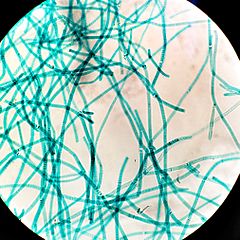
Schopf's work helped demonstrate that phytoplankton evolved long before land plants and were probably the first photosynthetic organisms. In fact, Schopf and his colleagues eventually found structures in 3.5 billion-year old rocks from Western Australia that resemble phytoplankton (see Figure 2 for some examples) (Schopf, 1993). If these structures really are microfossils, they would be some of the oldest forms of life on Earth.
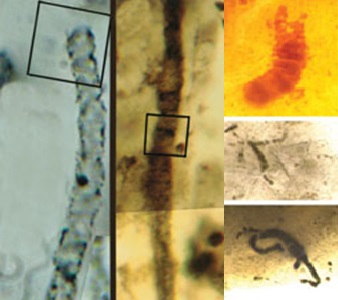
However, distinguishing microfossils in rocks that old is not straightforward or easy. Many scientists still debate the origin of Schopf's specimens and point to features in other rocks that look similar but are not fossils at all. Instead, they are physical structures unrelated to living organisms (Brasier et al., 2002). Regardless of when these organisms first appeared, it is not clear that they photosynthesized and produced oxygen, even though they look like modern phytoplankton. In the end, figuring out when oxygen began to accumulate in Earth's atmosphere would require multiple lines of evidence in addition to fossils.
Comprehension Checkpoint
Which is an older form of life on Earth?
Banded iron formations: Timing the rise of oxygen
Because it is difficult to determine precisely when photosynthesis evolved using the fossil record, geologists also looked to the minerals that make up rocks. They did so because minerals often reflect the chemistry of the environment at the time they formed. For example, consider the way that iron will rust if it is left out in the rain today – rust is the product of a chemical reaction between oxygen and iron, and reveals the presence of oxygen in the modern atmosphere. In the same way, geologists can use the properties of older rocks to determine the nature of past environments.
In the 1960s, Preston Cloud, a geology professor at the University of California, Santa Barbara, became interested in a particular kind of rock known as a Banded Iron Formation (or BIF). These deposits consist of dark-colored, iron-rich layers primarily in the form of magnetite (Fe3O4) and hematite (Fe2O3) alternating with bright red layers of chert, which consists of silica (SiO2). Silica is normally colorless, but in this case, the particles of silica are coated with iron oxide, which makes the bands red (see Figure 3). BIFs were already famous for another reason: They were (and still are) the primary source of iron for making automobiles. They have been found all over the world, in Australia, South Africa, Greenland, Canada, and Michigan, among other places, but no BIFs are younger than about 1.8 billion years old.
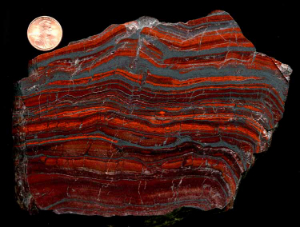
Cloud realized that the widespread occurrence of BIFs meant that the conditions needed to form them must have been common on the ancient Earth, and not common after 1.8 billion years ago. Shale and chert often form in ocean environments today, where sediments and silica-shelled microorganisms accumulate gradually on the seafloor and eventually turn into rock. But iron is much less common in younger oceanic sedimentary rocks. This is partly because there are only a few sources of iron available to the ocean: isolated volcanic vents in the deep ocean and material weathered from continental rocks and carried to sea by rivers (see our module The Rock Cycle).
Most importantly, it is difficult to transport iron very far from these sources today because when iron reacts with oxygen gas, it becomes insoluble (it cannot be dissolved in water) and forms a solid particle. Cloud understood that for large deposits of iron to exist all over the world's oceans, the iron must have existed in a dissolved form. This way, it could be transported long distances in seawater from its sources to the locations where BIFs formed. This would be possible only if there were little or no oxygen gas in the atmosphere and ocean at the time the BIFs were being deposited. Cloud recognized that since BIFs could not form in the presence of oxygen, the end of BIF deposition probably marked the first occurrence of abundant oxygen gas on Earth (Cloud, 1968).
Cloud further reasoned that, for dissolved iron to finally precipitate and be deposited, the iron would have had to react with small amounts of oxygen near the deposits. Small amounts of oxygen could have been produced by the first photosynthetic bacteria living in the open ocean. When the dissolved iron encountered the oxygen produced by the photosynthesizing bacteria, the iron would have precipitated out of seawater in the form of minerals that make up the iron-rich layers of BIFs: hematite (Fe2O3) and magnetite (Fe3O4), according to the following reactions:
4Fe3 + 2O2 → 2Fe2O3
6Fe2 + 4O2 → 2Fe3O4
The picture that emerged from Cloud's studies of BIFs was that small amounts of oxygen gas, produced by photosynthesis, allowed BIFs to begin forming more than 3 billion years ago. The abrupt disappearance of BIFs around 1.8 billion years ago probably marked the time when oxygen gas became too abundant to allow dissolved iron to be transported in the oceans.
It is interesting to note that BIFs reappeared briefly in a few places around 700 million years ago, during a period of extreme glaciation when evidence suggests that Earth's oceans were entirely covered with sea ice. This would have essentially prevented the oceans from interacting with the atmosphere, limiting the supply of oxygen gas in the water and again allowing dissolved iron to be transported throughout the oceans. When the sea ice melted, the presence of oxygen would have again allowed the iron to precipitate.
Comprehension Checkpoint
How can the study of rocks help scientists discover the beginnings of photosynthesis on Earth?
Other evidence for the rise of oxygen
Fortunately, BIFs were not the only geochemical evidence that something in Earth's atmosphere changed around 2 billion years ago. Heinrich Holland, a geologist at Harvard University, and Cloud both independently found evidence in the minerals pyrite (iron sulfide) and uraninite (a form of uranium). In contrast to the iron that formed BIFs, pyrite and uraninite exist as insoluble solids without oxygen. Holland found that sedimentary rocks that preserve ancient river deposits from before 2 billion years ago contain particles of these minerals, but none after. This could mark when oxygen concentrations became high enough to make pyrite and uraninite soluble and difficult to preserve as solids – the opposite process as BIFs, but caused by the same changes in the atmosphere and exhibiting the same timing (Holland, 1962).
Just as the deposition of BIFs slowed and stopped in the oceans, iron-rich layers in soils started forming on the continents. These layers are commonly known as redbeds because of their bright red hue – a color they derive from the oxidized iron they contain (Figure 4). The presence of oxidized iron in redbeds suggests that atmospheric oxygen gas must have been abundant when they formed. While many redbeds younger than 2 billion years exist around the world, none have been found to be older. This is yet another line of evidence supporting the idea that atmospheric oxygen became abundant around 2 billion years ago.
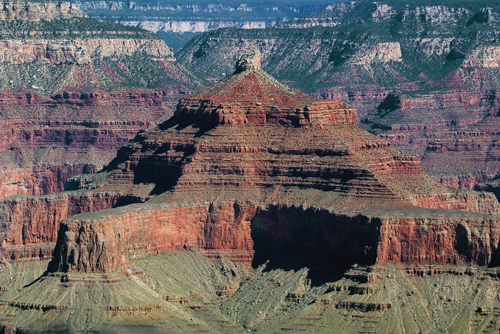
Most convincing of all, however, was evidence from the stable isotopes of sulfur preserved in ancient rocks. Isotopes are atoms of an element that have a different number of neutrons. Some decay radioactively, while stable ones like the isotopes of sulfur do not. In the case of sulfur, there are 4 stable isotopes: The most abundant form of sulfur has 16 protons, 16 neutrons and an atomic mass of 32 (shown as 32S). Its isotopes are 33S (17 neutrons), 34S (18 neutrons), and 36S (20 neutrons) (Figure 5).
Although all of these sulfur atoms participate in the same chemical reactions and form the same molecules, they each behave a little differently because of their different masses. Most of the time, the lighter isotope (32S) more readily participates in chemical reactions because it is energetically more favorable than the heavier isotopes. That means that for a normal reaction, the product will contain more 32S, and less of the heavy isotopes. In fact, the abundance of heavy isotopes usually decreases following an expected relationship with more 33S and less 36S. When this happens, scientists say that the process followed mass-dependent fractionation.
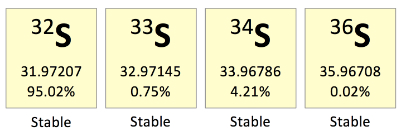
However, a few reactions do not depend on the mass of the sulfur isotopes involved. These reactions mostly occur in the stratosphere where intense ultraviolet radiation interacts with sulfur gases, and there is enough energy for all the isotopes to react. In these cases, the amount of heavy isotopes does not follow the expected relationship, and the process results in mass-independent fractionation (MIF).
Measurements of sulfur isotopes in the modern atmosphere reveal that very little mass-independent fractionation takes place today. This is due to two factors: first, the UV radiation needed to drive these reactions is absorbed high in the atmosphere by oxygen gas and ozone, preventing it from interacting with sulfur gases. Second, most sulfur gases today react with O2 to a form a soluble compound that is quickly removed from the atmosphere by rain, before it has time to react with UV radiation. In other words, the presence of oxygen prevents MIF.
But was this always the case? In 2000, James Farquhar, a scientist at the University of California, San Diego, published a study extending the record of sulfur isotope measurements back in time. He and his collaborators measured the isotopes of sulfur in rocks up to 4 billion years old. They expressed their results in terms of Δ33S, which is the ratio of 33S measured in the sample to 33S expected for mass-dependent fractionation (see a graph of their measurements in Figure 6).
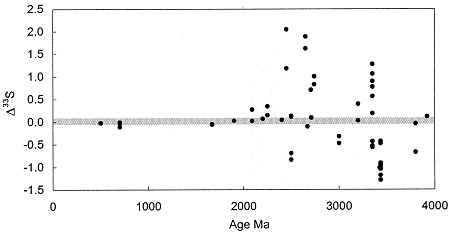
Although the sulfur he measured is now trapped in minerals, some of it started out as a sulfur gas, and inherited its isotopic composition from this earlier phase. If all the samples measured at a given time cluster around zero (Δ33S=0), this means that mass-dependent fractionation was the dominant process governing the sulfur cycle and oxygen was likely present in the atmosphere. Any value of Δ33S that differs from 0, in either a positive or negative direction, suggests that mass-independent fractionation occurred at this time, meaning little to no free oxygen gas was present in the atmosphere.
Farquhar's record shows that much more MIF occurred in the past (Figure 6). Specifically, it appears that the amount of MIF varied dramatically before 2.4 billion years ago and then stopped shortly thereafter (Farquhar et al., 2000). This suggests that in the early atmosphere, oxygen did not interfere with sulfur's stratospheric chemistry and that sulfur was preserved in rocks in many different oxidation states, not just the soluble form of sulfate (SO4
Using sulfur isotopes, Farquhar and other geochemists provided the most conclusive evidence yet that the early atmosphere did not contain very much oxygen gas, and that a relatively sudden event caused it to rise between 2.4 and 1.8 billion years ago. However, his conclusions were supported by the previous work of Cloud, Holland, Schopf, and others. All of their evidence together — from fossils to banded iron formations to sulfur isotopes — helped scientists determine that the early Earth lacked oxygen and pinpoint when it first appeared.
This episode is now known as the Great Oxidation Event, the moment when Earth became the first known planet to contain substantial amounts of oxygen gas in its atmosphere (Figure 7). The Great Oxidation Event occurred between 2.4 and 1.8 billion years ago. After that, the concentration of oxygen gas remained low for another billion years, before increasing again until the present.
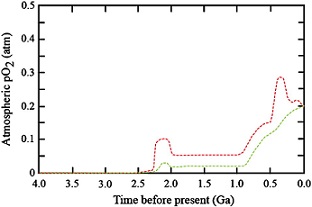
Comprehension Checkpoint
The most important information about the amount oxygen gas in the early atmosphere came through measurements of
Ongoing questions
There are still many outstanding questions about the Great Oxidation Event, the timing of the rise in oxygen, and the evolution of photosynthesis. There appears to have been a delay between the evolution of photosynthesis (probably more than 3.5 billion years ago), the Great Oxidation Event (which began approximately 2.4 billion years ago), and the end of BIF formation 1.8 billion years ago, which remains poorly understood. And scientists are still working to understand just how much oxygen gas might have been in the atmosphere before the Great Oxidation Event.
Even after the Great Oxidation Event, oxygen levels remained much lower than today, yet another mystery. Oxygen only reached modern concentrations about 600 million years ago, for reasons scientists still debate, and then remained mysteriously constant until the present, leaving much to be understood about the evolution of Earth's atmosphere. However, everything we learn about Earth's past helps us understand what can happen in the future as the composition of the atmosphere continues to change.
Summary
The composition of Earth's atmosphere has evolved over time. This module examines how Earth came to be the only planet in the universe known to contain oxygen gas. The module explores the advent and rise of oxygen in Earth's atmosphere. Evidence described includes the rock record, bands of iron in sediment, microscopic fossils, and isotopes of sulfur.
Key Concepts
-
Earth's early atmosphere had a different composition than the modern atmosphere and contained very little oxygen gas.
-
The rise of oxygen gas in Earth's atmosphere was dependent upon the evolution of photosynthesizing bacteria in the oceans.
-
Our knowledge about the rise of oxygen gas in Earth's atmosphere comes from multiple lines of evidence in the rock record, including the age and distribution of banded iron formations, the presence of microfossils in oceanic rocks, and the isotopes of sulfur.
Source: https://www.visionlearning.com/en/library/Earth-Science/6/History-of-Earths-Atmosphere-II/203
0 Response to "What Was and Continues to Be the Source of Atmospheric Oxygen"
Post a Comment